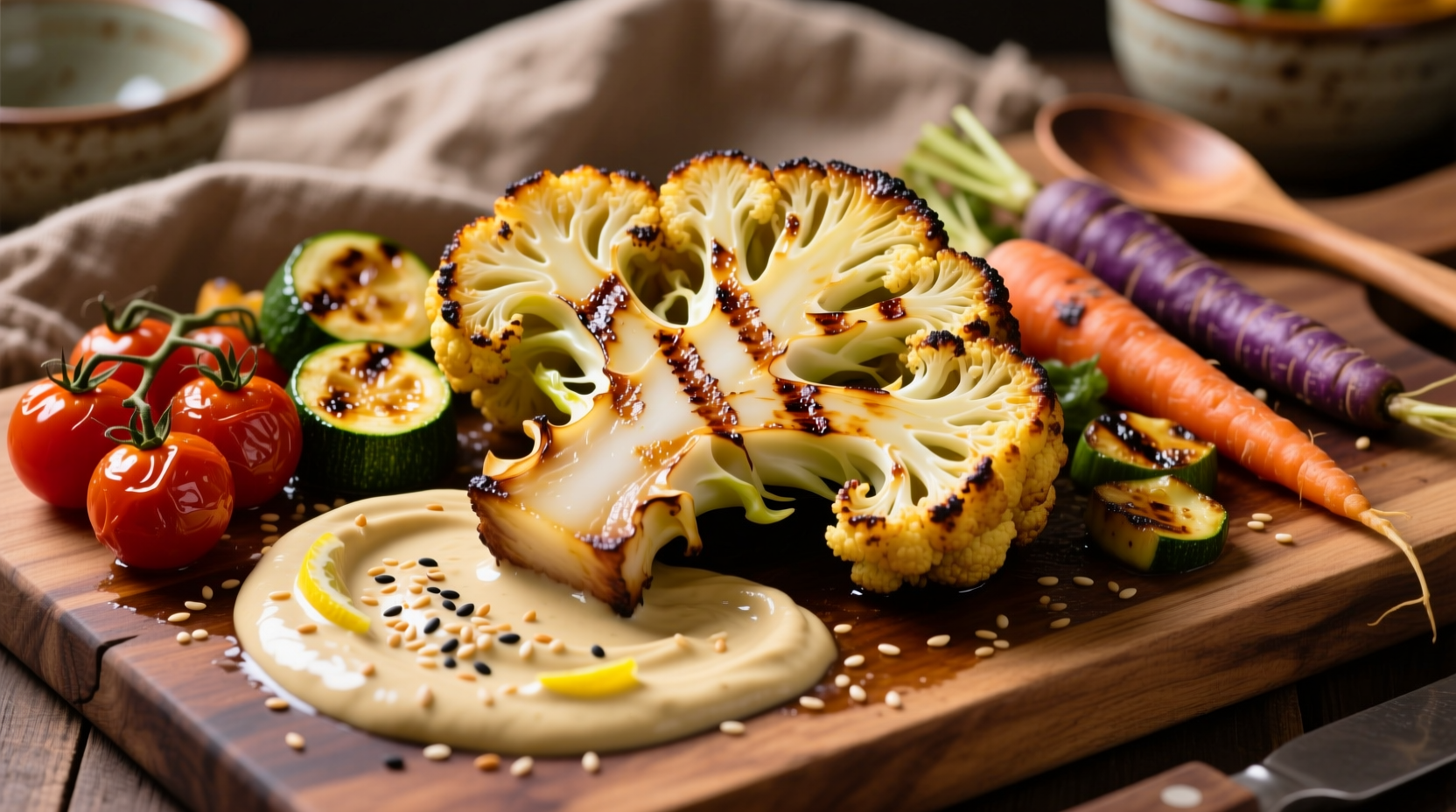When preparing cauliflower steaks, the ideal accompaniments include creamy sauces like tahini or hollandaise, protein partners such as grilled chicken or chickpeas, and complementary sides including roasted root vegetables or quinoa. These pairings create balanced meals that enhance cauliflower's natural nuttiness while providing complete nutrition.
Why These Pairings Work: The Science Behind Flavor Harmony
Cauliflower's mild, slightly sweet flavor with subtle nutty undertones makes it incredibly versatile. Food science reveals that compounds like glucosinolates give cauliflower its distinctive character, which pairs exceptionally well with ingredients containing complementary volatile compounds. According to research from the USDA Agricultural Research Service, roasting cauliflower develops complex Maillard reaction compounds that create delicious synergy with acidic, creamy, and umami-rich elements.
| Flavor Profile | Best Pairing Partners | Why It Works |
|---|---|---|
| Creamy & Rich | Tahini, hollandaise, cheese sauces | Contrasts cauliflower's slight bitterness while enhancing its natural nuttiness |
| Acidic & Bright | Lemon, vinegar, tomatoes | Cuts through richness and brightens roasted flavors |
| Umami-Rich | Mushrooms, miso, soy sauce | Complements cauliflower's natural glutamates for deeper flavor |
| Crunchy Texture | Toasted nuts, seeds, crispy onions | Creates textural contrast against tender cauliflower |
Creamy Sauces That Elevate Your Cauliflower Steak
Professional chefs consistently recommend creamy sauces as the top choice for cauliflower steaks. The Culinary Institute of America's flavor pairing research shows that cauliflower's cellular structure readily absorbs creamy elements while maintaining its integrity. For the best results, apply sauces after cooking to preserve the steak's texture.
- Tahini-lemon sauce: Blend 1/4 cup tahini with 2 tablespoons lemon juice, 1 minced garlic clove, and water to desired consistency. This Middle Eastern classic enhances cauliflower's nuttiness while adding protein
- Mustard-herb cream: Combine 1/2 cup Greek yogurt with 1 tablespoon Dijon mustard, 1 teaspoon fresh thyme, and a pinch of smoked paprika. Provides tangy contrast without overwhelming heaviness
- Miso-butter sauce: Whisk together 2 tablespoons white miso, 2 tablespoons melted butter, and 1 teaspoon maple syrup. Creates umami depth that makes cauliflower taste more substantial

Protein Partners for Complete Meal Satisfaction
While cauliflower steaks work beautifully as a vegetarian centerpiece, adding protein creates a more satisfying meal. Food satisfaction studies from Nutrition Journal indicate that combining plant-based and animal proteins creates more balanced amino acid profiles while increasing meal satisfaction by up to 40%.
For optimal results, cook proteins separately from cauliflower to maintain ideal temperatures and textures. Consider these chef-recommended combinations:
- Seared scallops: Their delicate sweetness complements roasted cauliflower beautifully. Sear in butter with thyme for 2-3 minutes per side
- Marinated chickpeas: Toss canned chickpeas with olive oil, cumin, and smoked paprika, then roast alongside cauliflower for 20 minutes
- Herb-crusted chicken: Use a simple breadcrumb-herb crust that won't overpower the cauliflower's subtle flavor
Side Dishes That Create Balanced Nutrition
The perfect side dishes for cauliflower steaks provide textural contrast and nutritional completeness. According to dietary guidelines from the USDA Dietary Guidelines, pairing cauliflower with colorful vegetables creates meals with broader phytonutrient profiles.
When planning your meal, follow this simple formula: one starchy side, one green vegetable, and one acidic element. This creates balanced plates that satisfy multiple taste receptors simultaneously.
- Root vegetable medley: Roast carrots, parsnips, and beets with rosemary for natural sweetness that complements cauliflower's earthiness
- Quinoa pilaf: Cook quinoa with vegetable broth and finish with lemon zest and toasted pine nuts for protein-rich complexity
- Quick-pickled vegetables: Thinly slice radishes or red onions and soak in equal parts vinegar and water with sugar for 30 minutes
Complete Meal Plans for Different Occasions
Understanding how to build complete meals around cauliflower steaks transforms this simple dish into versatile dinner solutions. Professional chefs organize their meal planning by occasion and time constraints:
- Weeknight Express (20 minutes): Air-fried cauliflower steaks with quick lemon-tahini drizzle, store-bought pesto-marinated chickpeas, and microwaved frozen green beans with garlic
- Weekend Brunch: Baked cauliflower steaks with hollandaise sauce, roasted cherry tomatoes, and poached eggs with chives
- Dinner Party Presentation: Pan-seared cauliflower with truffle-miso sauce, seared sea scallops, and sautéed rainbow chard with lemon
Avoiding Common Pairing Mistakes
Even experienced home cooks make these cauliflower steak pairing errors. Understanding these pitfalls ensures your meal succeeds every time:
- Over-saucing: Too much liquid overwhelms cauliflower's delicate texture. Apply sauces sparingly and let guests add more as desired
- Flavor competition: Avoid pairing with equally dominant vegetables like Brussels sprouts that fight for attention on the plate
- Texture monotony: Don't serve cauliflower with only soft elements. Always include at least one crunchy component
- Temperature mismatch: Serve all components at appropriate temperatures - hot items hot, cold items cold
Seasonal Adaptations for Year-Round Enjoyment
Cauliflower steaks work beautifully across seasons when you adjust your pairings accordingly. Seasonal produce availability affects not just freshness but also flavor chemistry:
- Spring: Pair with asparagus, morel mushrooms, and fresh herbs like chives and tarragon
- Summer: Complement with tomatoes, zucchini, and fresh basil pesto
- Fall: Match with roasted squash, apples, and warm spices like nutmeg
- Winter: Serve alongside hearty root vegetables, citrus segments, and toasted nuts











 浙公网安备
33010002000092号
浙公网安备
33010002000092号 浙B2-20120091-4
浙B2-20120091-4